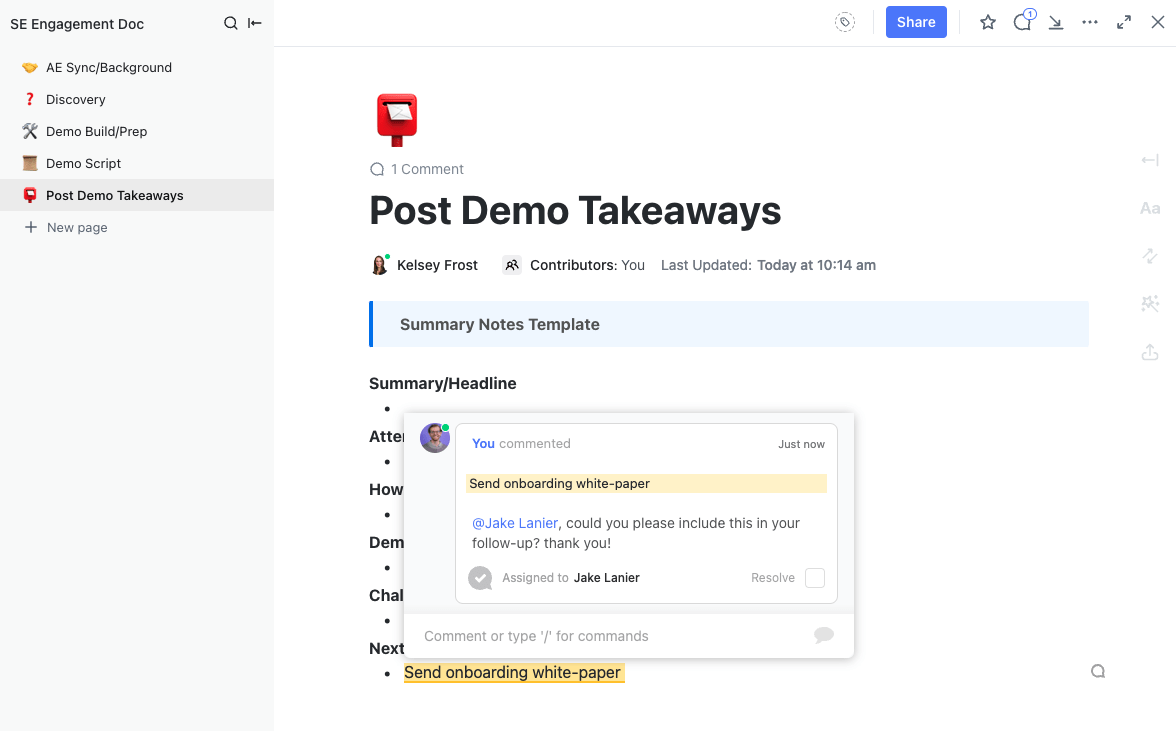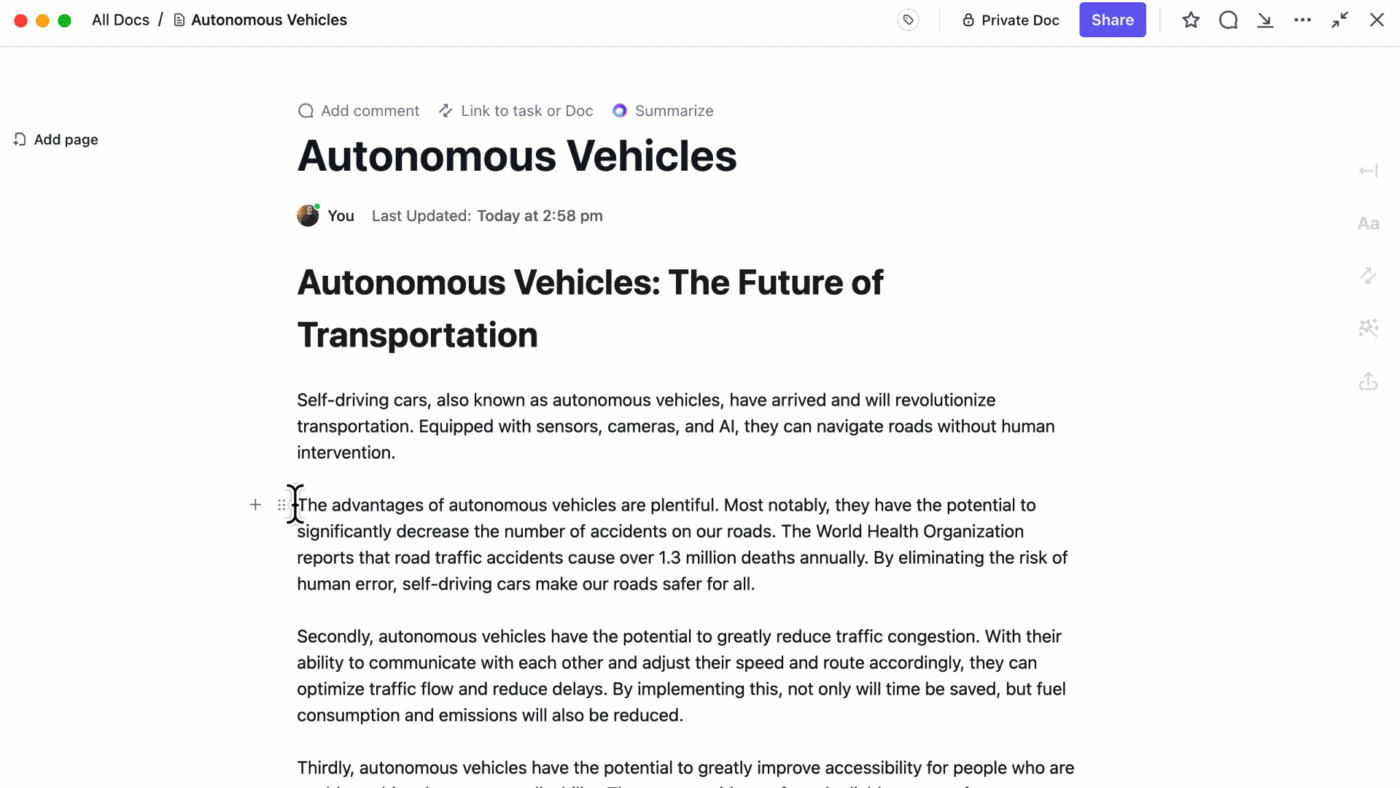How to Write a Report for Maximum Clarity and Impact

Sorry, there were no results found for “”
Sorry, there were no results found for “”
Sorry, there were no results found for “”
If you’re a professional in any industry, you know that sharing ideas and findings through well-crafted reports is a skill that will set you apart from your peers.
But writing a compelling report may seem daunting at first. It requires a well-thought-out approach.
What elements or sources should you incorporate to ensure your report is comprehensive and engaging? And how do you organize each section for maximum impact?
In this guide, we’ll explore the ins and outs of report writing, breaking it down step by step. We’ll also introduce you to some game-changing features in ClickUp, a platform that will make your report-writing journey smoother and more collaborative. Let’s dive in!
Before we explore the intricacies of how to write a report, let’s establish a solid understanding of what report writing entails. Report writing encompasses the art and science of transforming raw information into a cohesive and structured document.
A well-crafted report is more than a collection of facts; it’s a narrative that provides clarity, insight, and direction. In business, accurate and insightful reports help with informed decision-making.
Adept report writing is a strategic skill that distills complex data into understandable insights. Whether documenting project progress, detailing financial metrics, or analyzing market trends, reports provide a medium.
Reports take various forms in academic and professional settings. In academia and business, research reports provide insights into scientific studies. Policy-makers rely on book reports, and field study reports for ground-level information.
A project report or summary is a comprehensive document that outlines a project’s objectives, progress, challenges, and outcomes. Writing effective project reports demands attention to clear objectives, systematic data collection, and a concise presentation of findings.
Progress, technical, functional, marketing, academic, sales reports, and case studies serve diverse purposes. Each type is purposefully crafted to fulfill specific objectives, catering to the distinct needs within organizations.
Despite their differences in subject, these reports adhere to common attributes, principles, and formats in report writing.
Here, we’ll explore five common types of reports and explain their distinct characteristics. We’ll also show you how to write a report for successful outcomes in your respective fields.
Research reports meticulously explore a specific topic, utilizing surveys, experiments, or literature reviews. Geared toward contributing to existing knowledge, these reports offer a detailed and authoritative understanding of the subject.
Key features include an extensive literature review, a well-defined methodology, a systematic presentation of findings, and conclusive insights derived from rigorous research.
When writing a research report, start with a clear and focused research question. Conduct thorough literature reviews to identify existing gaps.
Define a precise methodology, outlining your approach step by step. Present your findings in a structured manner, ensuring clarity in your delivery. Employ conclusive insights to draw actionable conclusions.
Business reports intricately analyze business-related information, which includes financial performance, project updates, and strategic plans.
They inform stakeholders, investors, or internal teams about business operations and performance metrics.
A comprehensive report includes financial statements and concise summaries of ongoing projects. It also provides strategic recommendations tailored to the specific needs and interests of the target audience.
Start with a clear executive summary, move on to financial analysis, offer insights into profitability and performance indicators.
Prioritize clarity and brevity to communicate complex information effectively. Use data visualization tools when necessary to enhance understanding.
Technical reports convey complex technical information, procedures, or analyses. Predominantly utilized in science and engineering, these reports aim to communicate intricate technical details.
Specialized language, detailed procedures, and precise data presentation are hallmarks of technical reports, requiring a certain level of expertise for comprehension. These reports often serve as valuable technical references, aiding decision-making, troubleshooting, and further research.
As a professional, ensure your technical reports cater to the specific needs of your audience.

Leverage technical writing software and tools to enhance the precision and effectiveness of your communication. They help maintain a delicate balance between technical depth and clarity for seamless comprehension.
Detail procedures meticulously, leaving no room for ambiguity and aiding professionals in replicating processes or methodologies. Precisely present data, graphs, or tables to reinforce findings.
Incident reports involve the meticulous documentation of unexpected events or issues. They’re typically written down, outlining real events, the sequence of events, and the corresponding responses.
These are designed to analyze incidents thoroughly, learn from them, and establish preventive measures for future occurrences.
Detailed descriptions of the incident and its immediate and potential impact form the core of incident reports. Recommendations for improvement ensure a comprehensive understanding and proactive approach.
When drafting incident reports, ensure a detailed chronology of events and responses.

Incident report templates guide professionals in crafting detailed narratives, ensuring comprehensive documentation.
Consider the templates for documentation and to enhance preparedness, minimize risks, and cultivate a safer and more resilient environment in your field.
Progress reports track the ongoing development of a project or initiative, documenting achievements, challenges, and future plans.
They’re primarily geared toward providing decision-makers with valuable insights and relevant data, enabling informed decision-making.
These reports include milestone tracking, performance indicators, project reports, and a narrative that details the project’s progress and outlines anticipated future milestones.
To create an effective progress report, focus on quantifiable achievements and challenges. Tailor the report to decision-makers, providing them with a concise and forward-looking overview.
Now, let’s delve deeper into the essential components of a well-structured report.
To write impactful reports, you need to grasp the basics. From the initial impression set by the title page to the nuanced details in appendices and executive briefs, each element plays a vital role in improving the report’s effectiveness and readability.
Here are the key components contributing to a comprehensive report’s structure and depth.
Serves as the face of the report, providing crucial information at a glance. It includes title, author’s name, date, and relevant institutional information.
Summarizes the report’s main points. Offers a quick overview for readers with time constraints, acting as a stand-alone summary highlighting key findings and recommendations.
Outlines the structure and organization of the report, aiding readers in navigation. Accuracy in page references is vital, ensuring a reliable roadmap for easy access to specific content areas.
Acts as the opening chapter, setting the stage for the report. States the report’s purpose and scope, offering a concise yet comprehensive overview of what follows. Guides readers toward a clear understanding of the report’s objectives and what they can expect within its content.
Details of how the research or analysis was conducted. Essential for transparency, allowing others to replicate the study and verify its validity.
Presents the main outcomes or discoveries derived from the research. Backed by data, evidence, or examples, ensuring the credibility and reliability of the presented findings.
Interprets the report findings, providing context and deeper understanding. Offers insights and potential implications, elevating the report beyond a mere presentation of facts.
Suggest actions based on the report’s findings. Provides decision-makers clear directions on how to respond to the presented information.
Summarize the report’s key points. Reinforces the main theme, leaving a lasting impression on the reader.
Cites sources used for reference in the report, ensuring its credibility and allowing for further exploration. Adheres to a standardized citation format for most reports, enhancing the report’s professionalism and academic integrity.
Let’s explore a few additional components that enhance a report’s completeness. Incorporating these into your report ensures it is a valuable and impactful document in your professional endeavors.
You need the right tools and a systematic approach to write effective reports. Let’s explore the intricacies of report creation.
Here are the practical steps to craft a good report that grabs attention and delivers impact:
Before you start writing a report, clearly define why you’re creating the report and who will be reading it.
Ask yourself: What is the main objective of the report or article? Is it to inform, persuade, or analyze? Understanding your audience is paramount.
Tailor your language, tone, and content to cater to your readers’ specific needs, expectations, and level of expertise.
Gather all necessary information through extensive research and credible sources, ensuring a well-rounded understanding of your subject matter. To expedite this process, leverage ClickUp AI features. Utilize its advanced capabilities to quickly summarize lengthy documents, extracting key insights efficiently.

Explore a diverse array of over a hundred meticulously crafted and research-backed AI tools, offering tailored solutions for every role and use case.
Incorporating AI streamlines your research and improves the precision of data extraction.
Before you start writing, plan the structure of your report. Develop a comprehensive roadmap outlining each section, ensuring your narrative’s logical flow and coherence.
A well-structured outline acts as a guide, facilitating seamless transitions between ideas and topics. To simplify this task, use ClickUp AI’s intuitive features to create organized outlines.
This optimization refines your report’s structure, enhancing readability, overall quality, and impact.
Leverage ClickUp Docs for a seamless writing experience beyond traditional document creation. Take advantage of the platform’s collaborative features like Assigned Comments for efficient teamwork.

Here’s how to utilize ClickUp Docs to expedite your workflow and enrich your work experience.

Unleash your creativity and conquer writer’s block with various advanced AI writing tools like ClickUp AI. It provides a dynamic solution for brainstorming, generating content, and breaking creative barriers.
Utilize ClickUp’s Checklists to ensure a systematic approach to your tasks, covering all necessary points seamlessly. Stay on top of your progress and deadlines, enhancing your productivity and reducing the risk of overlooking crucial details.
Keep all your work organized by categorizing Docs within ClickUp, facilitating easy access and searchability. Ensure the security of your Docs with privacy and edit controls, allowing you to manage who can access and edit your documents.
After completing your first draft, reviewing your report for clarity, coherence, and accuracy is crucial. Ensure your ideas flow seamlessly, maintaining a logical structure throughout the document. Utilize writing assistant software for valuable insights into your writing style. Whether refining grammar, improving sentence structure, or fine-tuning vocabulary, the best writing assistant software is a virtual guide. These advanced tools also suggest improvements, enhancing your report’s overall readability.

To enhance your editing process, leverage ClickUp’s advanced commenting features. Solicit feedback from colleagues directly within the document to promote constructive input.
Ensure there are no grammatical mistakes or typos. ClickUp’s collaborative features make it easy for multiple eyes to review.
Attention to formatting is pivotal for a polished and professional-looking report. Ensure consistency in font styles, headings, spacing, and alignment throughout the body of the report.
ClickUp’s versatile templates are an excellent starting point, offering pre-designed layouts that can significantly enhance your report’s visual appeal.
From case study templates and daily report templates to annual report templates, ClickUp offers a variety of templates for quick content creation.
Leveraging these templates streamlines the formatting process, providing a structured framework.
Once you’ve confirmed that all the data in your report aligns with your standards, proceed to the finalization step. Double-check all components, including content, formatting, and accuracy.
Confirm that your report aligns with the initial purpose and effectively communicates your findings. Once satisfied, proceed to distribute your report to the intended audience.
Consider the most appropriate channels for dissemination, ensuring accessibility and relevance to the recipients. Whether through email, a shared platform, or a presentation, choose a method that aligns with your audience’s preferences.
Templates are a game-changer when it comes to report writing. They provide a structured starting point, saving you time and ensuring consistency.
With predefined structures, formats, and prompts, content writing templates help streamline your writing workflow. Whether a seasoned writer or tackling a new project, incorporating free content writing templates into your toolkit can significantly boost productivity.
Here are some ClickUp templates to leverage:

The Report Cover Template in ClickUp efficiently creates professional and visually appealing covers for various reports. It streamlines the design process and customization options, allowing users to:
Steps to use the Report Cover Template involve setting the tone, selecting suitable designs, adding necessary details, finalizing, and printing. Collaboration, brainstorming, and progress tracking are facilitated within ClickUp’s workspace.

The Report Requirements Template by ClickUp offers an efficient and organized approach to creating comprehensive reports. It streamlines the process by:
This template helps you:
The Report Requirements Template facilitates project requirement documentation for business analysts. Integrating this template into your ClickUp Workspace helps maintain cohesion and clarity within teams, streamlining the process from report conceptualization to delivery.

Project reporting is crucial for a project manager to gauge a project’s health and address critical areas needing attention. The Project Reporting Template comprehensively overviews high-level Key Performance Indicators (KPIs) and overall project performance.
It assists in monitoring essential project elements such as tasks, expenses, and pending action items. Click Up’s Project Reporting Template is a centralized tool for project managers, providing insights into the project’s progress and potential bottlenecks.
With a clear snapshot of crucial project metrics, managers make informed decisions and allocate resources effectively to ensure project success. Streamline your project reporting with this template, covering key project elements.
By incorporating these templates into your report-writing process, you save time. You benefit from a proven framework designed to enhance the clarity and organization of your report.
In today’s dynamic professional environment, proficient communication through reports is indispensable. Whether conveying research findings, business updates, or project progress, mastering the art of report writing can elevate your career. ClickUp AI features and Click Up Docs transform the writing process into an efficient, collaborative, and enjoyable journey. So, when you undertake your next report-writing venture, follow the steps, embrace the templates, and let ClickUp be your ally in crafting impactful reports.
© 2025 ClickUp